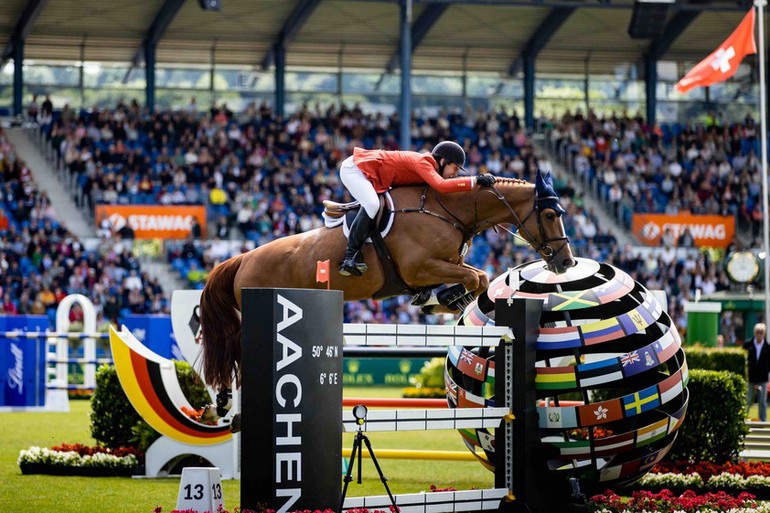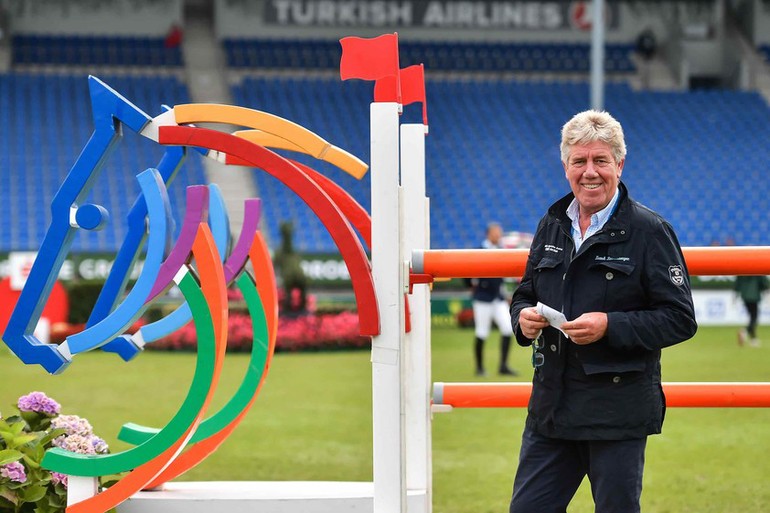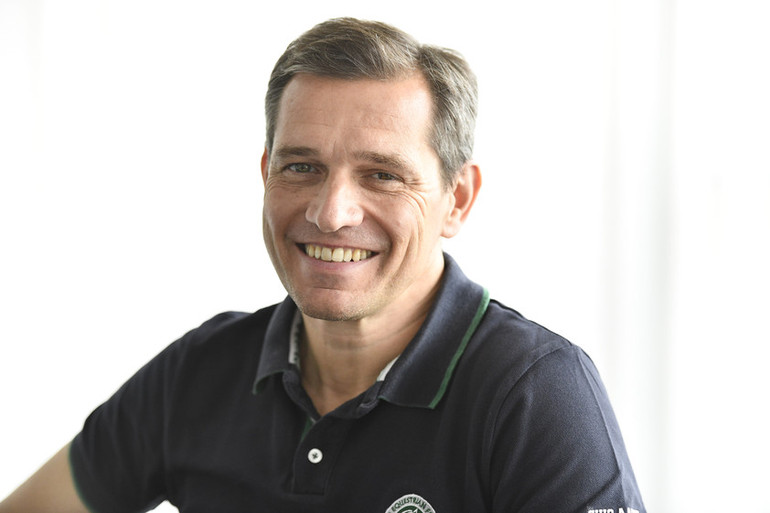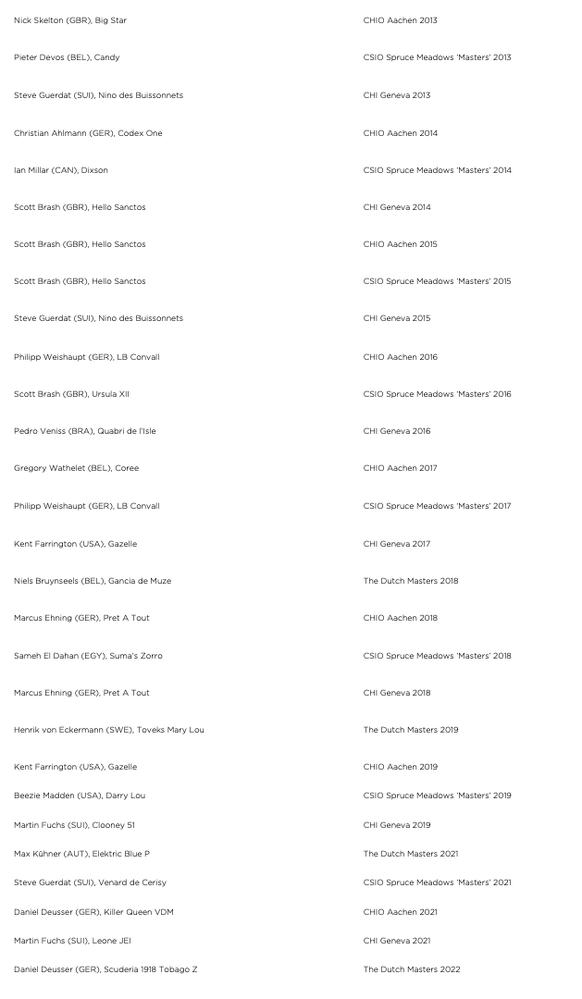Press release from Rolex Grand Slam of Show Jumping
Fifty of the world’s best show jumpers and their equine partners contested Friday’s feature jumping class – the RWE Prize of North Rhine-Westphalia – in front of an excited and enthusiastic crowd, which would serve as the final opportunity for riders to qualify for Sunday’s Rolex Grand Prix, one of the four Majors which comprises the Rolex Grand Slam of Show Jumping.
A 1.60m competition featuring a jump-off, the Frank Rothenberger-designed course included 14 obstacles, providing a tough challenge to a line-up that included 1992 Individual Olympic champion, Germany’s Ludger Beerbaum, fellow compatriot and the current Rolex Grand Slam Live Contender, Daniel Deusser, and Swiss maestro and Rolex Testimonee, Steve Guerdat.
Sixteen combinations eventually navigated the first round fault-free, advancing to the jump-off, which would be contested over a shorter eight-obstacle, but no less demanding, course. The first five riders to go, including Ireland’s Conor Swail and Germany’s Jana Wargers, each picked up one fault; however, sixth to go, Frenchman Nicolas Delmotte, soon broke the trend going double clear in 42.95 seconds. Delmotte’s clear was shortly emulated by Germany’s Christian Kukuk and Jur Vrieling of The Netherlands, with the latter crossing the line in 42.79 seconds to temporarily take top spot. Vrieling’s lead however was short-lived, with current world number 29-ranked rider, Steve Guerdat knocking over four tenths off his time.
With two riders to go, including Dutchman Harrie Smolders and McLain Ward from the USA, Guerdat faced an anxious wait, hoping his time would be unbeatable. However, Wednesday’s winner of the Turkish Airlines-Prize of Europe, McLain Ward, and his consistent partner, Contagious, soon demonstrated their harmony and class, knocking Guerdat off top spot, crossing the line in 41.70 seconds to claim the honours.
Delighted with his second win in as many days aboard his 13-year-old chestnut gelding, Ward, commented: “I think he’s [Contagious] on really good form and we’re aiming him towards the World Championships, it’s one of the reasons we had this week planned for him, so we’ll stick to our plan and hopefully be able to be in the mix.”
On his partner for Sunday’s Rolex Grand Prix, Ward, said: “It’s always nice to have a good week, as it gives you confidence. It makes you take a breath and focus. Azur [HH Azur] is older now and I know her very well, she’s my old friend. We’ll just do what we do, I don’t think today or Wednesday has much to do with what’s going to happen on Sunday. We’ll just focus and do the best job we can on the day.”
Walk the course with: Frank Rothenberger
How do you see the future of course designing?
Course designing is always developing – it runs parallel to our education around horses. As the riding improves, the strides are getting smaller, so we have to adjust the distance combinations between jumps. I’ve done this job for 40 years, and when I started, we had big bulky jumps, but this has almost gone. Now we have smaller, more open jumps with light poles. The length of the poles has reduced to 3.5m here in Aachen, when before it was always four metres. We changed this about six or seven years ago, so the jumps are much lighter now. It's very difficult nowadays to get the right number of clears. Years ago, out of 40 riders, 10 could win the class, but nowadays 30 are sometimes in contention.
What’s your favourite course designing memory?
I remember here at Aachen, we once had 25 horses in a class and the course we built had every jump down except one. Out of 25 horses! That was a really, really nice course and I always remember it. Another memory was when I was in Calgary, and they asked me to supply the course plans before the show. I said, ‘no, I haven't been here before, so I must see the ring, the arena, and the position of the cameras first’. And then they forced me to do the course plan. In the end we had to change everything because we had a lot of rain overnight so the plans no longer worked, so we had to prepare everything all over again.
When and where was the first course that you designed, as head course designer?
I believe it was a national show, and I built a course with 20 jumps, but that was maybe 40 years ago. I remember when I built my first Nations Cup course in 1992 in Poland. I wasn’t actually allowed to build it because my name wasn’t on the list, but a Polish course designer put his name on paper, but I built it. That was really funny. I’ve done 97 Nation Cups so far – and really hope to reach 100
You must be delighted that this year’s edition of the CHIO Aachen is going ahead with full capacity?
Yes – we are very happy. It is the first, full capacity CHIO Aachen to take place in the last three years [since 2019]. It is great to have all the best riders from around the world compete here, do the show and in particular, take part in the Rolex Grand Prix on Sunday.
Is there anything new this year that CHIO Aachen has introduced?
One of the major developments and focus areas has been the digital movement to improve the communication issues, which now means some classes that are not on television are available to watch. We have 109 hours of equestrian sport here across five disciplines and only about 30 hours are shown on television. So there has been a lot of content which is simply not being shown on television. Hence, we have been trying to see which target groups we could reach via new social media channels. One example is TikTok, which allows us to reach the younger audience effectively. On TikTok, viewers can now follow classes live on the app that are not shown on television. We really focused on what we could do with the amazing content that we have and how we could amplify it.
We are also evolving and have ventured into the metaverse and NFT space. In the CHIO Aachen Metaverse, the NFT is a “CHIO horse” and there are 1,000 horses available. Owners of such an NFT automatically become members of an exclusive community – the “CHIO Horse Club”. The first one was presented to McLain Ward yesterday evening [Wednesday 29 June]. As with all new innovations, it takes time to develop the metaverse offering but it is a really great opportunity and one that adds another element of fun to CHIO.
About the Rolex Grand Slam of Show Jumping
The Rolex Grand Slam is considered by the sport to be the ultimate equestrian challenge, primarily due to the sporting prowess required to achieve this feat. It is a quest taken on by the world’s top riders, vying to secure the legendary status associated with winning the Rolex Grand Slam of Show Jumping.
The format of the Rolex Grand Slam of Show Jumping is simple: anyone who wins three Majors in a row receives the Rolex Grand Slam trophy and a €1 million bonus on top of the class’s prize-money. If that same rider then continues their success by winning a fourth Major in succession, they will be rewarded with an additional €1million bonus. If two shows are won in succession, the bonus is €500,000 or if an athlete wins only 2 majors in a period of four successive shows, the bonus is €250,000.












